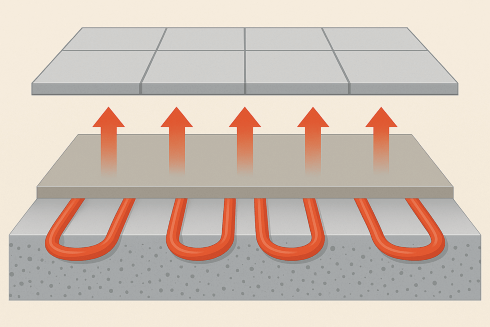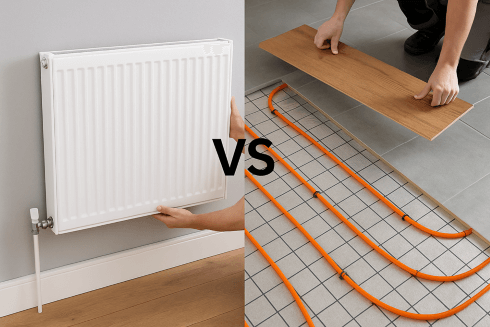In the quest for home comfort and energy efficiency, UK homeowners often find themselves torn between two popular options: traditional radiators and modern underfloor heating. Both systems offer unique benefits, but which one truly suits the UK climate, lifestyle, and property types? In this comprehensive comparison, we explore the pros and cons, costs, installation factors, and long-term efficiency of each heating method to help you make an informed decision.
In this comprehensive comparison, we explore the pros and cons, costs, installation factors, and long-term efficiency of each heating method to help you make an informed decision.
1. The UK Climate: What Are We Dealing With?
The UK's climate is largely temperate maritime, meaning relatively mild winters, frequent rainfall, and fluctuating temperatures. While not as harsh as continental climates, the unpredictable nature of UK weather demands a heating solution that is responsive, efficient, and ideally controllable room-by-room.
Key Climate Factors to Consider:
- Winter temperatures range from -2°C to 7°C in most regions
- Quick weather changes demand fast-reacting heating
- Older housing stock often lacks adequate insulation
2. Radiators: Reliable and Responsive
Radiators have been a staple of British homes for decades. Powered by boilers (gas, electric or heat pump-compatible), they work by heating water and transferring warmth to the air through convection.
Pros of Radiators:
- Quick to heat up and cool down
- Easy to zone with thermostatic radiator valves (TRVs)
- Ideal for retrofit installations
- Broad variety of sizes, styles, and outputs
Cons of Radiators:
- Can cause uneven heat distribution (hot near radiator, cold elsewhere)
- Less floor space for furniture and decor
- Radiators require regular maintenance (bleeding, balancing, flushing)
Ideal For:
- Older homes with limited insulation
- Quick-response heating for unpredictable weather
- Properties where minimal floor disruption is required

3. Underfloor Heating: Discreet and Comfortable
Underfloor heating (UFH) operates either electrically or via warm water (wet systems), heating the floor surface evenly and radiating warmth upward.
Pros of Underfloor Heating:
- Even heat distribution across entire room
- No visible units; more wall and floor space
- Compatible with renewable energy systems
- Comfortable barefoot warmth
Cons of Underfloor Heating:
- Slower to heat up and cool down
- More expensive to install, especially in retrofit projects
- May require floor level adjustments or insulation layers
- Best paired with tile, stone, or engineered wood flooring
Ideal For:
- New builds and major renovations
- Open-plan living areas and bathrooms
- Homes with good insulation

4. Efficiency Comparison: Which Is Cheaper to Run?
Both systems can be energy-efficient, but their performance varies depending on usage, insulation, and energy source.
5. Installation Considerations
Radiators are easier and cheaper to install in most UK homes, especially when replacing old units. Underfloor heating, while desirable, often requires:
- Lifting floorboards or screed
- Adding insulation layers
- Specialist labour
- Extended drying/curing time for wet systems
For retrofits, electric UFH is often chosen due to its low-profile nature, though it tends to be more expensive to run than wet UFH.

6. Zoning and Smart Control
Both systems support smart control, but their flexibility differs.
- Radiators: Use TRVs or smart valves per room
- Underfloor Heating: Zoned thermostats allow multi-room scheduling
Radiator systems respond faster to individual room changes, while underfloor heating provides consistent background warmth ideal for continuous low-temperature heating.
7. The Verdict: Which Is Right for You?
Choose Radiators If:
- You live in an older property with poor insulation
- You want a fast-response system
- You are retrofitting and want minimal disruption
- You prefer room-by-room control
Choose Underfloor Heating If:
- You’re building or renovating and want a seamless look
- Your home is well-insulated
- You prefer a more consistent, silent heating experience
- You plan to integrate renewables like heat pumps
Did You Know?
Underfloor heating systems operate effectively at lower temperatures (around 27–29°C), whereas traditional radiators often require 60–75°C—making UFH ideal for pairing with energy-efficient heat pumps.
Conclusion: Not Just a Battle A Choice of Fit
Radiators and underfloor heating both have a place in modern British homes. The UK’s climate, with its mix of damp winters and mild temperatures, requires adaptable and efficient solutions. In truth, the best option may be a hybrid system: radiators upstairs, underfloor heating downstairs.
The right solution depends not only on the budget and property type but also on how you live in your space.
Before choosing, consult a qualified heating engineer, perform a room-by-room heat loss calculation, and think long-term.
FAQ's
Yes, underfloor heating reduces air circulation compared to radiators, which can stir up dust, making it a better option for allergy-prone individuals.
Absolutely. Many UK homes use hybrid systems radiators upstairs for quick heating, and underfloor heating downstairs for constant comfort.
Radiators typically heat up much faster than underfloor heating, making them ideal for quick-response heating during the UK's unpredictable temperature shifts.









